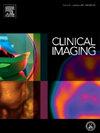Beyond the image: The hidden problem of maladaptive mindsets in radiology residency and how to fix it
IF 1.5
4区 医学
Q3 RADIOLOGY, NUCLEAR MEDICINE & MEDICAL IMAGING
引用次数: 0
Abstract
Purpose
Burnout, anxiety, and imposter syndrome are prevalent in radiology residency, where high clinical demands and a culture of perfectionism can reinforce maladaptive cognitive patterns. This study examines the prevalence of maladaptive and growth mindsets among residents and evaluates the impact of a brief educational intervention.
Methods
A 45-min didactic lecture on mindset theory was delivered to radiology trainees at five institutions. The lecture introduced three maladaptive mindsets - “Cog in the Wheel,” “Survival,” and “Perfectionist” - and one growth mindset, “Growth.” An anonymous post-lecture survey assessed mindset prevalence and the perceived importance of growth mindset development. Pearson's chi-square test was used for statistical analysis.
Results
Among 48 resident responses, 65 % identified with the “Perfectionist”, 62 % with “Survival,” and 56 % with “Cog in the Wheel” mindset. Only 6 % identified exclusively with the “Growth” mindset, while 35 % endorsed both growth and maladaptive mindsets. Only 8 % of respondents reported high familiarity with mindset theory pre-lecture. Ninety-percent of respondents rated growth mindset development as “very” or “extremely important” (p < 0.001) post-lecture, compared to 39 % retrospective rating pre-lecture. Additionally, 88 % found the session very helpful, and 75 % expressed high interest in further mindset training.
Conclusion
Maladaptive mindsets are prevalent among radiology residents, contributing to stress and burnout. A brief educational intervention significantly increased awareness and motivation to adopt a growth mindset. These findings underscore the need for structured mindset training, faculty modeling of growth-oriented behaviors, and institutional support to foster resilience and professional fulfillment. Future research should explore the long-term impact of mindset interventions.
影像之外:放射科住院医师不适应心态的隐藏问题及如何解决
目的:职业倦怠、焦虑和冒名顶替综合症在放射科住院医师中普遍存在,高临床要求和完美主义文化会强化不适应的认知模式。本研究考察了居民中适应不良和成长心态的流行程度,并评估了简短教育干预的影响。方法对五所院校的放射学学员进行45分钟的心态理论教学。讲座介绍了三种适应不良的心态——“车轮中的齿轮”、“生存”和“完美主义者”——以及一种成长型心态——“成长”。一项匿名的课后调查评估了心态的流行程度和成长心态发展的重要性。采用Pearson卡方检验进行统计分析。结果在48份居民回复中,65%的人认为自己是“完美主义者”,62%的人认为自己是“生存主义者”,56%的人认为自己是“车轮中的齿轮”。只有6%的人完全认同“成长”心态,而35%的人同时认同成长和适应不良心态。只有8%的受访者表示在课前对心态理论非常熟悉。90%的受访者认为成长心态的发展“非常”或“极其重要”。0.001),而讲座前的回顾性评分为39%。此外,88%的人认为培训非常有帮助,75%的人对进一步的心态培训非常感兴趣。结论放射科住院医师普遍存在适应不良心态,导致压力和倦怠。一个简短的教育干预显著提高了采用成长心态的意识和动机。这些发现强调了有必要进行结构化的心态培训,教师对成长导向行为的建模,以及机构支持,以培养适应力和职业成就感。未来的研究应该探索心态干预的长期影响。
本文章由计算机程序翻译,如有差异,请以英文原文为准。
求助全文
约1分钟内获得全文
求助全文
来源期刊

Clinical Imaging
医学-核医学
CiteScore
4.60
自引率
0.00%
发文量
265
审稿时长
35 days
期刊介绍:
The mission of Clinical Imaging is to publish, in a timely manner, the very best radiology research from the United States and around the world with special attention to the impact of medical imaging on patient care. The journal''s publications cover all imaging modalities, radiology issues related to patients, policy and practice improvements, and clinically-oriented imaging physics and informatics. The journal is a valuable resource for practicing radiologists, radiologists-in-training and other clinicians with an interest in imaging. Papers are carefully peer-reviewed and selected by our experienced subject editors who are leading experts spanning the range of imaging sub-specialties, which include:
-Body Imaging-
Breast Imaging-
Cardiothoracic Imaging-
Imaging Physics and Informatics-
Molecular Imaging and Nuclear Medicine-
Musculoskeletal and Emergency Imaging-
Neuroradiology-
Practice, Policy & Education-
Pediatric Imaging-
Vascular and Interventional Radiology
 求助内容:
求助内容: 应助结果提醒方式:
应助结果提醒方式:


